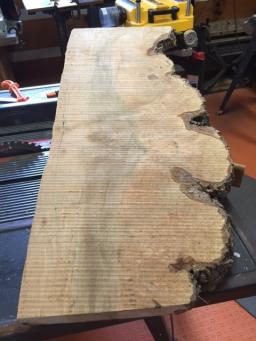The rule for air drying green wood is one year per inch of thickness. Seal the end grain so it won't lose moisture too quickly or the peice will crack of check. I just paint the ends with whatever latex house paint I have laying around. Elmer's Glue works just fine as well. I wouldn't put the wood in a room with wood heat. There is no substitute for patience when it comes to air drying. In the old days, a father would cut the wood his son would use.
Drying freshly harvested wood...
Thany you every one. I will keep you informed,
. Any body ever use thr techniqe of whacking the butt end to determine moisture content?
The paraffin on the ends will keep the wood from drying too quickly. I dried some walnut in my unheated attic for several years. I just stacked and stickered it and left it there until I needed it for a project. Sounds like you are on the right track.
Ken
"The dulcimer sings a sweet song."
Yea, i won't put it near the fire place, just in the same room which geet warm enough. Also we use a small fan which generally keeps the air smoothly gently circulating.
Thanks Kusani,
pretty much what I figured too. We have a wood stove insert in the fireplace in our livingroom. Puts out nice dry heat. I think I may put the wood slabs in proximity and help speed up thr dryng process. Fresh cut wood smells the best no matter what kind it is!
Nice looking pieces of wood! I would dry them 'as is' and then work them down to dimensions using whatever tools/machines you have available. Here is a slab of burl maple I air dried for 3+ years in a barn and then worked it down for making the dulcimer I have posted in another thread: 
updated by @kusani: 01/20/17 07:27:48PM
Hi, according to my past experiences I feel quite competent in building my first dulcimer. However, I know I will have several if not many questions and clarifications along my jouney. Here are the first.
In our woods a tree which I believe to be in the cherry or birch family came crashing down, broken off about 8 feet above the ground. A closer inspection revealed that downy woodpeckers and flickers were the culprits. My good fortune is in the remaining tree on the ground with about 10" diameter.
Using my chain saw I cut 2 slabs about 1.5x10x48 inches (+ or -) for top and bottom. At this time there are pretty rough and need band saw and planer attention. My question are about seasoning and drying the slabs.
1. Should I leave the slabs rough and let dry-out before doing any cutting ?
or
2. Should I band saw and plane to a rough size, then dry out?
In either case I will seal ends with parafin and bees wax.
I also cut a 3x3x48 inch maple plank from which the side will be band sawed from. I ask the same questions about drying out. No 1. Or No.2 ?
I also have a slab of black walnut which was shed off on one of our trees as a large branch came down in the wind. This has been in my barn for five years and completely dry. This will become the fret board and head.
I am extremely grateful to have such nice wood made available from my own land in such a natural way.
Any suggestion about drying are very welcome.
Lastly, can anyone recomend plans or a book for building the tear drop appalachian mountain dulcimer. I am pretty comfortable about the box. Need some good detail on head stock and stringing.
thanks all, will post pictures as I progress!
Tim Good Man
